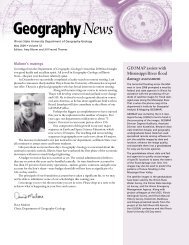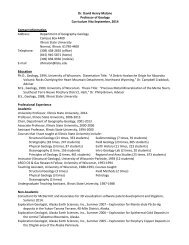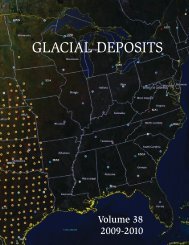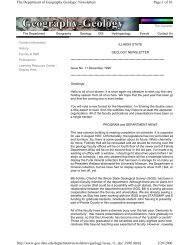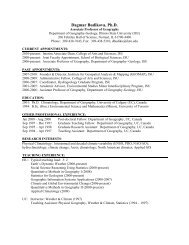04-1931 Geology Contact - Department of Geography - Geology
04-1931 Geology Contact - Department of Geography - Geology
04-1931 Geology Contact - Department of Geography - Geology
Create successful ePaper yourself
Turn your PDF publications into a flip-book with our unique Google optimized e-Paper software.
Jed Day and colleaguesready to board a helicopterfor a field excursion.Jake Morris is at far left.Jed is in the center.Day receives grant from thePetroleum Research FundPr<strong>of</strong>essor Jed Day with Dr. Mike Whalen <strong>of</strong> theUniversity <strong>of</strong> Alaska-Fairbanks is in year two <strong>of</strong> aproject entitled “Integrated Late Devonian EventStratigraphy, Western North America” funded forthe amount <strong>of</strong> $80,000 from the PetroleumResearch Fund <strong>of</strong> the American Chemical Society.They are developing detailed fossil data (conodontsand brachiopods) from numerous field sitesin and around Jasper National Park and Crownlands (Alberta Provincial lands) in western Albertaand eastern British Columbia. They will developdetailed age correlations between Middle and LateDevonian sea level events that controlled the timing<strong>of</strong> deposition <strong>of</strong> the main reef Devoanian buildupsand nearby carbonate shelf successions. They alsowill develop the timing <strong>of</strong> stepped extinction eventsculminating in the Late Devonian Mass Extinction.The researchers are also developing detailedmagnetic susceptibility (MS) records to documentassociated climate changes. In addition, they willproduce carbon and oxygen stable isotopic datafrom sampled brachiopod skeletal calcite and conodontapatites to identify and correlate stable isotopeevents. The purpose <strong>of</strong> that is to study secularchanges in near equatorial sea surface or upperwater mass temperature to assess climate changesin the Devonian tropical ocean.In 2003 Jake Morris participated in field operationsin the Jasper Park and the Cadomin areas,with field operations planned in the Kakwa Parkarea <strong>of</strong> eastern British Columbia for the summer<strong>of</strong> 20<strong>04</strong>.New continuing educationpartnership with IEPAOne important new initiative this year was thedevelopment <strong>of</strong> a continuing education partnershipwith the Illinois Environmental Protection Agency(IEPA). Led by IEPA scientist Sherry Otto ’79 thispartnership was set up to train IPEA personnel inthe regional geology <strong>of</strong> Illinois through field tripsto various parts <strong>of</strong> the state, and through specializedfield, laboratory, lecture, and workshop coursesin environmental geology and hydrogeology. In2003-20<strong>04</strong>, our department will receive $25,000to develop these courses.This year is the first in what promises to be along-term mutually beneficial partnership. The first<strong>of</strong> these courses was a run to LaSalle County inNovember. Skip, Bill, and I led about 30 IEPA pr<strong>of</strong>essionalson a two-day field trip that highlightedthe local geology.Additional courses are planned. One that I amlooking forward to is inviting IEPA scientists alongon the stratigraphy field trip to Western Illinois inApril. As in past years, we will spend two days inthe Barnes Hill area. This year though, IEPA peoplewill be teamed up with stratigraphy students tomeasure and describe sections and make the geologicmap. I hope our students will make some valuablecontacts, and that the IEPA people will benefitfrom the student energy and enthusiasm.Illinois State University developspartnership with NICOR Inc.One <strong>of</strong> the exciting new partnerships that wedeveloped this year is with NICOR Inc. NICOR is amajor natural gas provider in Northern and CentralIllinois. The company operates a number <strong>of</strong> undergroundstorage fields along the LaSalle AnticlinalBelt and elsewhere in the state. The natural gas isextracted from natural reservoirs in the Gulf Coastarea, and shipped by pipeline to Illinois. Duringthe summer months, gas is pumped back into theground to store for use in the winter heating season.Because <strong>of</strong> increasing demand, the size <strong>of</strong> some <strong>of</strong>the storage fields will need to increase. A morethorough geologic and hydrogeologic understanding<strong>of</strong> these fields is needed.Through the efforts <strong>of</strong> Art Sanders ’96 we developeda NICOR-funded research project for LaurenHunt, a current master’s student, which involvesdetermining the nature <strong>of</strong> gas loss within the TroyGrove Gas Storage Field in LaSalle County. The loss<strong>of</strong> gas is estimated to be about 2 percent per year.Gas may have migrated to other parts <strong>of</strong> the structureor to the overlying quaternary deposits. Itmay dissolve in the groundwater, or it may be lostthrough equipment problems. Lauren’s work willinclude shallow geophysical imaging, and numericaland analytical models to address these hypotheses.4






